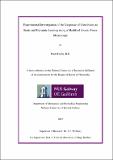| dc.contributor.advisor | McGarry, Patrick | |
| dc.contributor.author | Weafer, Paul | |
| dc.date.accessioned | 2013-08-01T10:23:20Z | |
| dc.date.available | 2013-08-01T10:23:20Z | |
| dc.date.issued | 2013-02-07 | |
| dc.identifier.uri | http://hdl.handle.net/10379/3590 | |
| dc.description.abstract | Cells and tissues continuously experience mechanical loading during daily activity. However, the mechanisms by which cells respond to mechanical stimuli are poorly understood. The focus of this thesis is to develop atomic force microscopy (AFM) techniques to investigate whole cell mechanics over physiologically relevant time scales, providing an in-depth understanding of the role of the actin cytoskeleton in osteoblast biomechanics. The work presented in this thesis can be divided into two categories: instrument development, and experimental cell biomechanics.
In terms of instrument development, the first key contribution of this thesis is the adaptation of a standard AFM to apply high precision mechanical loading at the whole cell level. Correction factors for AFM force and indentation measurements are developed, for the first time, to account for constraints imposed on AFM cantilever bending due to the attachment of a sphere at the cantilever's free-end. It is demonstrated that uncorrected force-indentation data may result in a dramatic ~18 fold underestimation of a sample¿s elastic modulus.
Using this modified AFM cantilever, high precision whole cell monotonic compression is applied to osteoblasts. It is found that the actin cytoskeleton contributes significantly (~40-60%) to the whole cell compression force. Additionally it is shown that the actively generated contractility of the actin cytoskeleton has a pronounced influence on cell and nucleus morphology.
The second key contribution in terms of instrument development is the stability enhancement of a standard AFM system to achieve accurate displacement control over long time scales. The methodology developed in this thesis for the reduction of thermal drift provides a significant 17-fold enhancement in z-drift stability. Furthermore, a customised fluid cell setup is developed to eliminate liquid instabilities during long term cell mechanics experiments.
This enhanced AFM system is used to implement cyclic single cell deformation, with a constant loading and unloading strain rate being applied to the cell. The range of applied deformation is altered during the experiment without altering the strain rate. It is demonstrated that steady state cell forces are largely unaffected by this change in deformation range. This phenomenon is not observed for non-contractile passive cells; measured forces for cells treated with cyto-D are found to be highly dependent on the applied deformation range. | en_US |
| dc.rights | Attribution-NonCommercial-NoDerivs 3.0 Ireland | |
| dc.rights.uri | https://creativecommons.org/licenses/by-nc-nd/3.0/ie/ | |
| dc.subject | Cell mechanics | en_US |
| dc.subject | Atomic force microscopy | en_US |
| dc.subject | Osteoblasts | en_US |
| dc.subject | Department of Mechanical and Biomedical Engineering | en_US |
| dc.title | Experimental Investigation of the Response of Osteoblasts to Static and Dynamic Loading using a Modified Atomic Force Microscope | en_US |
| dc.type | Thesis | en_US |
| dc.contributor.funder | Science Foundation Ireland | en_US |
| dc.local.note | Cells and tissues continuously experience mechanical loading during daily activity. However, the mechanisms by which cells respond to this loading are poorly understood. The focus of this thesis is to develop atomic force microscopy techniques to investigate whole cell mechanics over physiologically relevant time scales, providing an in-depth understanding of the role of the actin cytoskeleton in osteoblast biomechanics. | en_US |
| dc.local.final | Yes | en_US |
| nui.item.downloads | 548 | |


